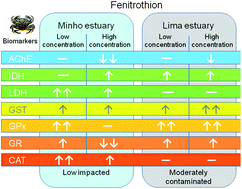Involvement of the antioxidant system in differential sensitivity of Carcinus maenas to fenitrothion exposure
Abstract
Carcinus maenas is an invertebrate with worldwide distribution and high ability to adapt to different environments, which is frequently used in environmental monitoring. Despite this, it is not clear how historical exposure to moderate contamination may influence sensitivity to further chemical stress in this important decapod species. This study investigated differential responses to organophosphate fenitrothion of C. maenas from a moderately contaminated estuary and a low impacted one, using in vitro and in vivo biomarker assays. To clarify potential differences in sensitivity, a biochemical characterisation of muscle cholinesterases was first performed. The results indicated acetylcholinesterase (AChE) as the main form present in C. maenas muscle. Exposure assays revealed that crabs from the moderately contaminated site were less sensitive to fenitrothion showing lower AChE inhibition than those from the low impacted site. Other biomarker changes detected in these animals were: increased anaerobic metabolism (muscle lactate dehydrogenase), enhanced phase II biotransformation (glutathione S-transferases in the digestive gland) and antioxidant defences (i.e., activities of glutathione reductase, glutathione peroxidase and catalase, and levels of total glutathiones in the digestive gland). Altogether, the results pointed out a role for the glutathione redox system towards tolerance to fenitrothion exposure.


 Please wait while we load your content...
Please wait while we load your content...